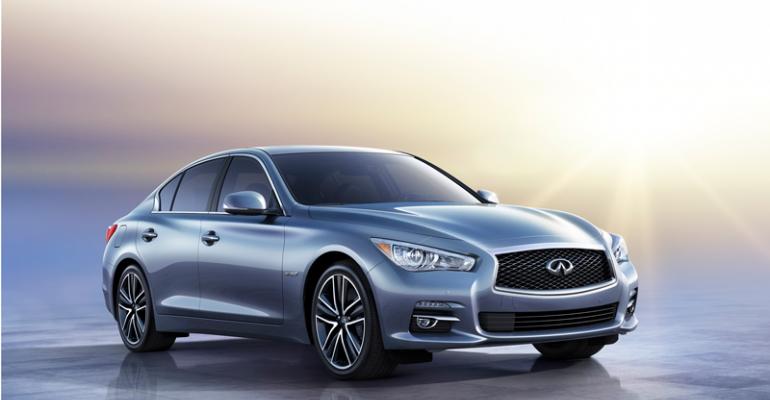DETROIT – The next generation of Infiniti’s entry luxury sport sedan bows at the 2013 North American International Auto Show.
Formerly known as the G, the car is rebadged the Q50 under Infiniti’s new naming strategy that labels all cars Q and all light trucks QX. The number represents a specific model line.
The Q50, like the outgoing G, offers a 3.7L V-6 engine but adds a new hybrid powertrain for ’14. In addition to exterior and interior design changes, the Q50 adds advanced safety technologies and expanded in-vehicle communications systems, many accessed via dual touchscreens.
“The new Q50’s athletic and tightened appearance blends its lower and wider proportions with enhanced interior roominess and stunning effect inside and out,” says Shiro Nakamura, chief design officer and a senior vice president of Infiniti parent Nissan.
Influenced by Infiniti concept cars of recent years, including the Essence unveiled at the 2009 Geneva auto show, the Q50 still retains Infiniti’s double-arch grille but now includes a 3-dimensional textured look that incorporates a waved mesh pattern and chrome surround.
The crescent-cut C-pillars are descendants of those on the Essence, Nakamura says. A- and B-pillar sashes are narrower for better ingress and egress and improved visibility from inside the cabin.
The Q50’s drag coefficient is 0.26, down from 0.29 in the outgoing G, thanks to improved upper- and lower-body airflow and zero front and rear lift.
The 3.7L VQ V-6 returning for ’14 still makes 328 hp and 269 lb.-ft. (365 Nm) of torque.
The new hybrid powertrain, with Infiniti’s Direct Response Hybrid system with Intelligent Dual Clutch Control, mates a 3.5L DOHC aluminum alloy V-6 gasoline engine, lithium-ion battery and the brand’s 1-motor/2-clutch motor control seen in the larger ’13 M hybrid.
The V-6, with Continuously Variable Valve Timing Control and Variable Valve Event and Lift, makes 296 hp and 255 lb.-ft. (346 Nm) of torque.
The electric motor generates 67 hp and 199 lb.-ft. (270 Nm) of torque on its own, and total system horsepower is 354.
Infiniti global boss Johan de Nysschen says the Q50 hybrid’s powertrain is “one of the fastest” in its class and “also happens to be projected as one of the most fuel-efficient,” although no fuel-economy figures are given.
Both the gas and hybrid models use Infiniti’s 7-speed automatic transmissions and come with either rear- or all-wheel drive.
The Q50 introduces Infiniti’s Direct Adaptive Steering technology, claimed as a world-first system that allows independent control of the tire angle and steering inputs. The advantage is driver intentions can be sent to the wheels faster than with a mechanical system, Infiniti says. There are four different settings available to the driver to control steering effort and steering-gear ratios.
Also claimed a world-first technology is Active Lane Control, a camera-based lane-keep system that adjusts for lane drift, road-surface changes, and crosswinds. ALC is available as part of the Lane Departure Prevention system offered on the Q50.
The new model introduces i-Key, which Infiniti says allows four distinct drivers to store settings for cabin temperature, audio, navigation and telematics. Settings are controlled via the two interior touch screens, which have “intuitive hand gesture screen operation.”
The screens, one high, one low on the center stack, work together, with a roadmap viewable on the upper screen and navigation settings on the lower screen.
Infiniti says further information will come at a later date on the Q50’s telematics system’s ability to download, update and synchronize personal apps through smartphones.
Nakamura says careful attention was paid to the Q50’s interior to harmonize all materials’ choices and design.
The double-wave instrument panel comes from the G, but is updated with an asymmetrical flow. A new seat design reduces backbone pressure, and thinner front-seat backs improve rear knee room. B-pillars are moved forward almost an inch (2.5 cm) for easier rear-seat access.
As is typical of Infiniti interiors, materials derived from history are employed in the Q50, including Kacchu aluminum, named for traditional Samurai armaments, and maple-wood trim inspired by a 16th century Japanese painting technique, Urushi.
Other safety technologies include intelligent cruise control, which will have full-speed range, Infiniti says, as well as a “predictive” forward collision warning system the brand claims as a world-first technology.
The Q50 goes on sale in the U.S. and Canada this summer, with the 3.7L V-6 and hybrid powertrains available at launch. Global rollout of the car, with added powertrains, also begins this summer.
There’s no word on pricing or sales expectations for the new model.
The ’13 G sedan starts at $37,350.
The G lineup’s best volume was 71,811 units sold in 2007, WardsAuto data shows.
Last year, Infiniti retailed 59,844 G37s and G25s, the latter with a 2.5L V-6. While G volume was up 2.7% from 2011, the car fell 40,000 units shy of BMW’s 3-Series in 2012, the No.1 seller in WardsAuto’s Lower Luxury car segment in the U.S.
While the 2.5L V-6, introduced for the mid-cycle change of the current G sedan, was discontinued for ’13, there are 4-cyl. and diesel models planned for global markets.
Details on the Q60 coupe and convertible models are due at a later date.




